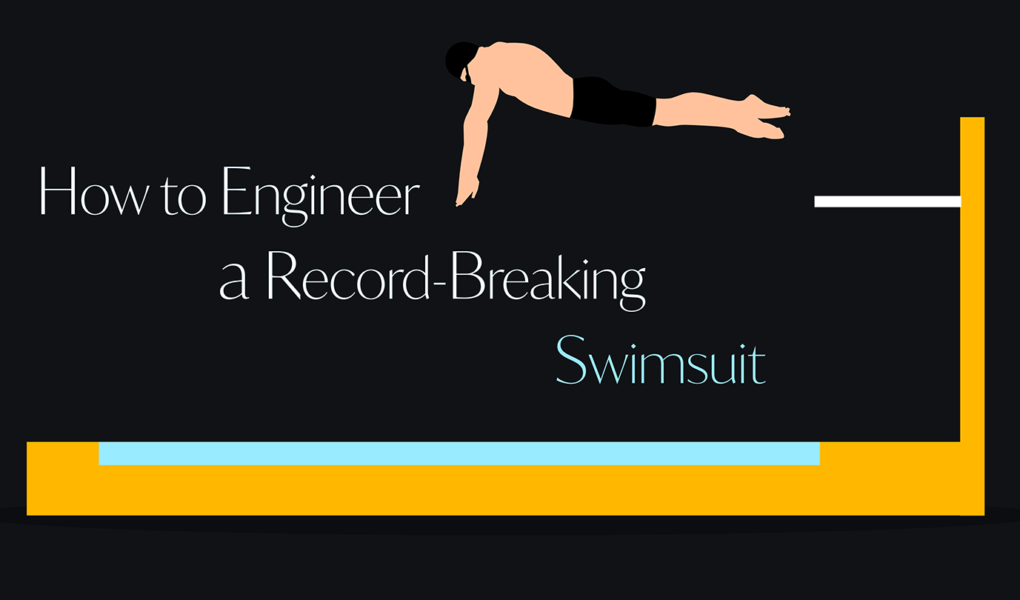Abstract
Competitive swimwear has increasingly become more high-tech since the 1990s. Recently, most medals won at the Olympics were won by swimmers wearing high-tech and highly engineered swimsuits. Likewise, most world records broken in the past 10 years were broken wearing high-tech swimsuits. As such, it is important to understand the engineering and technology behind these record-breaking suits to see how so many medals and records have been gained by these competitive swimsuits.
In a blink of an eye
One one-hundredth of a second was the difference between Olympic gold and silver at the 2008 Beijing Olympics in the 100-meter butterfly. It was the slimmest margin measured in the Olympics, and it resulted in Michael Phelps winning his 7th gold medal in Beijing and a $1 million bonus from Speedo. Almost unbelievably, Michael Phelps’s margin of victory was 10 times faster than a blink of an eye. While strength and technique are invaluable, in a sport where the winner is determined by a difference of a millisecond, the right suit can and will give swimmers a critical edge.
The Evolution of the Olympic Swimsuit
For most of the swimsuit’s history, it had been designed for practical or cultural reasons, not with the goal of swimming efficiency. At the beginning of the 20th Century, most swimsuits were made of woolen materials, designed to cover the entire body, and were not designed for speed. This began to change in 1928 when Speedo introduced their racerback silk suit that uncovered the shoulder blades.While controversial, this swimsuit soon became the norm [1]. By the 1950s, different materials were introduced in the making of swimsuits with Speedo becoming the first company to introduce nylon and elastane [1]. At the 1972 Olympics, East German swimmers wore tightly fitted “skinsuits” that, when wet, became basically transparent. The transparency and revealing shape of this new swimsuit sparked outrage [2]. However, critics were silenced in the 1973 World Aquatics Championships, where East German women won 10 of the 14 events and broke seven world records [2]. This paved the way for the “skinsuit”, refined with synthetic materials, to become the standard competitive swimwear.
Records Broken at a Record Pace: Engineering the Supersuit
Dramatic increases in world records and gold medals are seen with advances in competitive swimwear. With the introduction of new materials in suits, 21 out of 22 records (that’s more than 95%) at the 1972 Olympics were broken wearing nylon/elastane suits [3]. More recently, 13 out of the 15 world records broken at the 2000 Olympic games were in Fastskin swimsuits, which were some of the first highly engineered swimsuits. In fact, 83% of medals were won by swimmers wearing these swimsuits [4]. In the second generation of the Fastskin suit, swimmers earned 47 medals, and Michael Phelps won six gold medals using the Fastskin suit. With the introduction of the LZR Racer swimsuit, another highly engineered swimsuit, in 2008, swimmers wearing the suit at the 2008 Olympics set 23 out of 25 world records, won 94% of the races, and 89% of the medals [4]. By August of 2009 more than 130 world records had been broken by swimmers wearing highly engineered suits, with 43 world records broken at the 2009 World Championships. Since 2000, with the introduction of the first super suit, Fastskin, the majority of Olympic medals have been won by those wearing a highly engineered swimsuit. During the past 20 years, competitive swimwear has become an increasingly important facet of swimming competition, and as such, it is important to explore the engineering behind the modern record-breaking competitive swimsuit.
Engineering the Modern Swimsuit
Speedo’s sharkskin swimsuit
The Speedo R&D team began creating a new suit in the late 90s that eventually became the Fastskin suit. Released in 2000, the suit was designed to mimic shark skin. This made the human body more hydrodynamic—meaning it glided through the water with minimal resistance-— thus allowing the swimmer’s body to move more efficiently. When investigating materials that reduce skin friction in the water, the Speedo research team honed in on sharks. They learned that a shark’s skin is patterned with ridges called dermal denticles that reduce the amount of water that touches the shark’s skin as it swims [5]. These tiny, flat V-shaped scales decrease drag and turbulence, allowing the shark to swim faster. Speedo developed a material that was a water-repellent fabric with printed denticle features. However, that was not the only special design feature.
This swimsuit utilized compression technology and focused on the shape of the swimmer’s body in the water. Thus, the suit was extremely tight-fitting, which effectively changed the wearer’s body shape and improved dynamic flow [6]. It is important to note that a Harvard professor, George Lauder, revealed that the surface of the Fastskin swimsuit has little effect when it comes to reducing drag as swimmers move through the water, unlike shark skin [7]. Hence, the compression technology was the feature providing the most improvement on performance. While the suit is not as biomimetic as advertised, through its compression technology, it can change the circulation and increase the venous return to the body and is tailored to maintain proper swimming posture even when the swimmer is tired. Thus, although Speedo sought out to design a swimsuit based on shark skin, they ended up creating an incredibly successful suit due to other engineered properties of the suit, and further suits were developed with the focus shifted to changing the body shape.
What a drag – beating water’s pull
There are two main types of drag that slow a swimmer down: form drag and skin friction drag. Form drag is created because of the shape of a solid body traveling through a fluid. The more streamlined a swimmer is, form drag can be reduced. Skin friction drag is the drag between the surface (ie the swimmer’s body) and water. This is similar to the drag runners and cyclists encounter due to the wind pushing against them. Just like runners and cyclists, swimmers can reduce this drag with tighter-fitting swimsuits instead of baggy ones. A smoother surface influences the skin friction drag which can be reduced by an engineered swimsuit. Furthermore, form drag can be reduced with highly compressed suits that aid in maintaining proper swimming form.

Form drag and skin friction drag. [8]
Figure 1 shows that the shape of the object, in our case a swimmer, influences form drag. The larger you are, the more drag that occurs due to form drag. A simple way to reduce form drag is to make your body as streamlined and as small as possible.

In the above figure, Figure 2, Michael Phelps is seen above in a streamline that allows him to reduce form drag by making the area that hits the water as small as possible [9]. Highly engineered suits also reduce form drag by holding the body in a streamlined position. Skin friction drag is the friction that is due to the body moving through the water. For example, swimmers wear a swim cap to reduce skin friction drag as it creates a smooth surface to decrease the interactions the water has on your body as you move through the water. Also, swimmers shave their entire bodies to reduce the drag of body hair, creating a smoother surface to glide through the water. Similarly, high-tech suits are made of materials that create a smooth surface that repels water.
Rocketing through water
In 2008, Speedo launched the LZR Racer swimsuit, which was the most highly engineered and technically advanced swimsuit, based on elastane-nylon and polyurethane. Speedo collaborated with NASA and multiple international research institutes such as ANSYS, one of the world’s leading engineering simulation software providers, to create the new suit [10].
The LZR Racer, created to combat the forces of drag on the swimmer, held the body in a more hydrodynamic position and used synthetic materials to create a smooth, drag free surface.
In order to counter drag, the seams of the LZR Racer suit were ultrasonically welded. This means that the overlapping fabrics of the swimsuit were fused together instead of sewn, which helps to reduce drag even more as the water does not get caught in the seams. Moreover, through a special fabric made of nylon and spandex that were combined in a high-density weave, the LZR racer was able to reduce skin friction drag by 24% compared to the Fastskin suit [10]. Another key aspect of the suit is the compression system which molds the swimsuit to the body similar to a corset. This compression helps swimmers to maintain their form in order to swim longer and faster.
Another interesting aspect of the LZR Racer is the layers of materials used. Traditional competitive swimsuits use one layer of fabric; however, swimsuits composed of only one material tend to become too tight because of high material tension which hinders a swimmer’s ability to move freely. In order to combat this issue, Speedo utilized composite layers made of materials with various elastic properties which allow the body to move freely [11]. The base layer is called the LZR Pulse, which is fitted to the swimmer’s body. The additional panels made of thin polyurethane sheets are overlaid onto the surface of the LZR Pulse[11]. These panels are customized according to the movements of certain swim strokes. A freestyler moves differently than a backstroker in the water, and these suits are custom-made to these differences. For example, the panels that cover the quadriceps are specially designed to be shorter in the swimsuits for the breaststroke as compared to the swimsuits for freestyle. This is because the hip joints must be more mobile for breaststroke leg kicks.

LZR Racer suit with panels [10]
The LZR racer was nicknamed the “rubber suit” as it compressed a swimmer’s body into a streamlined tube and trapped air, making the swimmer more buoyant and reducing form drag. Speedo’s goal was to make the flow path as smooth and undisturbed as possible and used
computational fluid dynamics (CFD), the computer modeling of fluid flow, to use the compressive properties of the suit to make the swimmer as hydrodynamically efficient as possible[13]. One interesting aspect of the compressive properties of the suit was that it allowed for better oxygen flow to the muscles while holding the body together when tired to improve the swimmer’s performance. From silk sheets to rocket science, it is incredible to see how much engineering has been put into creating competitive swimsuits.
Conclusion: High-tech but low acceptance
However, because of the significant benefit of wearing a highly engineered swimsuit, there is much debate over whether or not these suits provide swimmers an unfair edge. Critics have argued that these engineered suits are unfair, and those who do not have access or cannot afford these super suits are at a huge disadvantage. The governing body of swim, FINA, has reacted to the criticism over competitive swimsuits made entirely of non-textile material, like the LZR Racer, by banning the use of non-textile materials in competitive swimsuits and enforcing stricter restrictions in permeability, buoyancy, thickness, and design[4]. In fact, the LZR Racer suit was so effective at reducing drag and improving performance that FINA banned the use of it as a form of “technological doping”, as it served to diminish natural ability which threatens the integrity of the sport.

Concept design of Speedo’s 2040 swimsuit [14]
As FINA cracks down on highly engineering suits, competitive swimsuit companies like Speedo are getting creative. Recently, Speedo unveiled a concept for what swimsuits might look like in 2040 shown above. Speedo has plans for eventually 3-D printing a custom-fit suit, molding to the athlete’s body, down to every muscle. Additionally, the newest Fastskin suit will feature an AI coach fit with micro sensors to monitor vitals like “oxygen saturation, glucose levels, and hydration. [15]. Due to the extreme levels of technology potentially incorporated into this suit, it will be interesting to hear the thoughts of FINA on this high-tech suit, and if it counts as a form of technological doping. The enormous engineering of the modern competitive swimsuit sparks and will continue to spark questions on how to balance technology and human effort as we see how fast athletes can truly go.
References
[1]P. Khosla and E. Pierson, “Witness the evolution of Olympic swimwear,” Glamor, 15-Aug-2016. [Online]. Available:
https://www.glamour.com/story/the-evolution-of-olympic-swimwear. [Accessed: 16-Oct-2021].
[2]J. Campbell, “Light, tight and right for racing – sports illustrated vault,” SI.com, 12-Aug-1974. [Online]. Available: https://vault.si.com/vault/1974/08/12/light-tight-and-right-for-racing. [Accessed: 16-Oct-2021].
[3] Speedo, “Speedo Fastskin – A History of the world’s fastest swimsuits,” SwimSwam, 01-Mar-2019. [Online]. Available:
https://swimswam.com/speedo-fastskin-a-history-of-the-worlds-fastest-swimsuits/. [Accessed: 16-Oct-2021].
[4] M. Pattinson, “History of competitive swimwear: From racerbacks to supersuits,” Swim England Competitive Swimming Hub, 16-Mar-2020. [Online]. Available:
https://www.swimming.org/sport/history-of-competitive-swimwear/. [Accessed: 16-Oct-2021].
[5]P. Jarreau, “Swim like a shark,” FromTheLabBench, 02-Jul-2016. [Online]. Available: http://www.fromthelabbench.com/from-the-lab-bench-science-blog/swim-like-a-shark. [Accessed: 16-Oct-2021].
[6]J. E. Wood, “Bio-Based Materials in Sportswear Applications,” in Encyclopedia of renewable and sustainable materials, S.l.: ELSEVIER, 2020, pp. 683–687.
[7]P. Reuell, “A swimsuit like shark skin? not so fast,” Harvard Gazette, 17-May-2019. [Online]. Available:
https://news.harvard.edu/gazette/story/2012/02/a-swimsuit-like-shark-skin-not-so-fast/. [Accessed: 16-Oct-2021].
[8] “Drag,” Aviation Online Magazine, 2014. [Online]. Available:
http://avstop.com/ac/thrust.html. [Accessed: 21-Oct-2021].
[9] M. Luebbers, “Overview of olympic swimming rules,” LiveAbout, 01-Jul-2018. [Online]. Available: https://www.liveabout.com/olympic-swimming-rules-3169864. [Accessed: 20-Oct-2021].
[10]University of Nottingham. “Engineering The World’s Fastest Swimsuit.” ScienceDaily. ScienceDaily, 1 March 2008. <www.sciencedaily.com/releases/2008/02/080228100709.htm>.
[11] D. Perez, “The technology behind Speedo’s high-tech swimsuits that challenged the Olympics by Denise Perez,” Engineering.com, Dec-2020. [Online]. Available: https://www.engineering.com/story/the-technology-behind-speedos-high-tech-swimsuits-that-cha llenged-the-olympics. [Accessed: 16-Oct-2021].
[12]S. Tang, “The rocket swimsuit: Speedo’s LZR Racer,” Science in the News, 09-Jan-2014. [Online]. Available: https://sitn.hms.harvard.edu/flash/2008/issue47-2/. [Accessed: 16-Oct-2021].
[13] Speedo’s patents on the LZR Racer suit: US Patent Publication number: US 2008/0141430; US Patent Publication number: US 2008/0141431
[14] M. Kollat, “Speedo’s AI-powered fastskin 4.0 is the ‘most intelligent swimsuit’ in the world no one can buy for another 20 years,” T3, 30-Jun-2021. [Online]. Available: https://www.t3.com/us/news/speedos-ai-powered-fastskin-40-is-the-most-intelligent-swimsuit-in -the-world-no-one-can-buy-for-another-20-years. [Accessed: 21-Oct-2021].
[15] V. Song, “Speedo’s swimsuit of the future will have you looking like Aquaman,” Gizmodo, 16-Jun-2021. [Online]. Available:
https://gizmodo.com/speedo-s-swimsuit-of-the-future-will-have-you-looking-l-1847112885. [Accessed: 21-Oct-2021].




